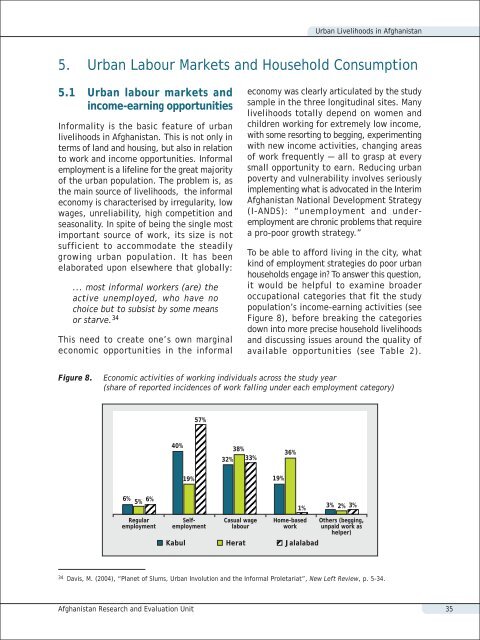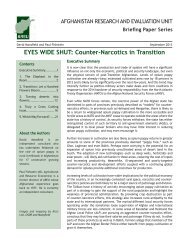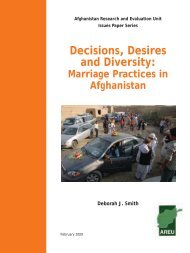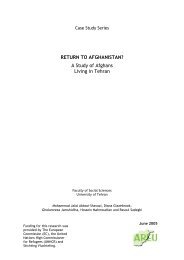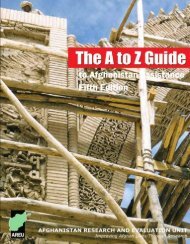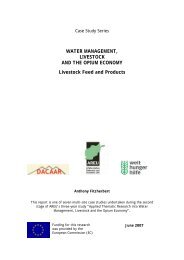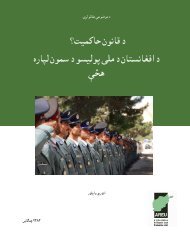Urban Livelihoods in Afghanistan - the Afghanistan Research and ...
Urban Livelihoods in Afghanistan - the Afghanistan Research and ...
Urban Livelihoods in Afghanistan - the Afghanistan Research and ...
Create successful ePaper yourself
Turn your PDF publications into a flip-book with our unique Google optimized e-Paper software.
<strong>Urban</strong> <strong>Livelihoods</strong> <strong>in</strong> <strong>Afghanistan</strong>5. <strong>Urban</strong> Labour Markets <strong>and</strong> Household Consumption5.1 <strong>Urban</strong> labour markets <strong>and</strong><strong>in</strong>come-earn<strong>in</strong>g opportunitiesInformality is <strong>the</strong> basic feature of urbanlivelihoods <strong>in</strong> <strong>Afghanistan</strong>. This is not only <strong>in</strong>terms of l<strong>and</strong> <strong>and</strong> hous<strong>in</strong>g, but also <strong>in</strong> relationto work <strong>and</strong> <strong>in</strong>come opportunities. Informalemployment is a lifel<strong>in</strong>e for <strong>the</strong> great majorityof <strong>the</strong> urban population. The problem is, as<strong>the</strong> ma<strong>in</strong> source of livelihoods, <strong>the</strong> <strong>in</strong>formaleconomy is characterised by irregularity, lowwages, unreliability, high competition <strong>and</strong>seasonality. In spite of be<strong>in</strong>g <strong>the</strong> s<strong>in</strong>gle mostimportant source of work, its size is notsufficient to accommodate <strong>the</strong> steadilygrow<strong>in</strong>g urban population. It has beenelaborated upon elsewhere that globally:... most <strong>in</strong>formal workers (are) <strong>the</strong>active unemployed, who have nochoice but to subsist by some meansor starve. 34This need to create one’s own marg<strong>in</strong>aleconomic opportunities <strong>in</strong> <strong>the</strong> <strong>in</strong>formaleconomy was clearly articulated by <strong>the</strong> studysample <strong>in</strong> <strong>the</strong> three longitud<strong>in</strong>al sites. Manylivelihoods totally depend on women <strong>and</strong>children work<strong>in</strong>g for extremely low <strong>in</strong>come,with some resort<strong>in</strong>g to begg<strong>in</strong>g, experiment<strong>in</strong>gwith new <strong>in</strong>come activities, chang<strong>in</strong>g areasof work frequently — all to grasp at everysmall opportunity to earn. Reduc<strong>in</strong>g urbanpoverty <strong>and</strong> vulnerability <strong>in</strong>volves seriouslyimplement<strong>in</strong>g what is advocated <strong>in</strong> <strong>the</strong> Interim<strong>Afghanistan</strong> National Development Strategy(I-ANDS): “unemployment <strong>and</strong> underemploymentare chronic problems that requirea pro-poor growth strategy.”To be able to afford liv<strong>in</strong>g <strong>in</strong> <strong>the</strong> city, whatk<strong>in</strong>d of employment strategies do poor urbanhouseholds engage <strong>in</strong>? To answer this question,it would be helpful to exam<strong>in</strong>e broaderoccupational categories that fit <strong>the</strong> studypopulation’s <strong>in</strong>come-earn<strong>in</strong>g activities (seeFigure 8), before break<strong>in</strong>g <strong>the</strong> categoriesdown <strong>in</strong>to more precise household livelihoods<strong>and</strong> discuss<strong>in</strong>g issues around <strong>the</strong> quality ofavailable opportunities (see Table 2).Figure 8.Economic activities of work<strong>in</strong>g <strong>in</strong>dividuals across <strong>the</strong> study year(share of reported <strong>in</strong>cidences of work fall<strong>in</strong>g under each employment category)57%6% 5%40%6%Regularemployment19%Selfemployment38%32% 33%Casual wagelabour19%36%1%Home-basedworkKabul Herat Jalalabad3% 3% 2%O<strong>the</strong>rs (begg<strong>in</strong>g,unpaid work ashelper)34 Davis, M. (2004), “Planet of Slums, <strong>Urban</strong> Involution <strong>and</strong> <strong>the</strong> Informal Proletariat”, New Left Review, p. 5-34.<strong>Afghanistan</strong> <strong>Research</strong> <strong>and</strong> Evaluation Unit 35


